
MARKET GUIDE: Scrapers
Peter Anderson looks at the mainstream towed and motor scrapers available in the UK, together with a review of prominent UK fleets
Motorised and towed scrapers are considered to be the most cost-effective way to move and place material, requiring fewer machines, and therefore operators, on site. They also consume less fuel per cubic metre shifted than excavators and articulated dump trucks (ADT). The origins of the scraper date back to the early 1800s when a horse was used to haul an agricultural implement resembling a large shovel. By the 1930s and 1940s earthmoving had become increasingly mechanised, with tracked tractors and pull scrapers being a common and effective way of excavating and transporting large amounts of earth.
Towed scrapers were superseded by motorised self-propelled scrapers, which were used in large numbers to construct the UK motorway network in the 60s and 70s. With fewer large scale muck-shifts over the next few decades, their use in the UK shrank dramatically. However, since the turn of the century, some earthmoving contractors have returned to towed scrapers, using an agricultural tractor as the prime mover, the combination being less costly than buying motor scrapers.
Single-engined motor scrapers and towed scrapers usually require the services of a dozer to help push them through the ground being removed, the common alternative being to temporary link two twin-engined motor scrapers, each assisting the other in the loading part of the cycle. With high global fuel costs and a continuing shortage of staff, we expect more contractors to take a fresh look at the many advantages of using scrapers in bulk muck-shifting work.
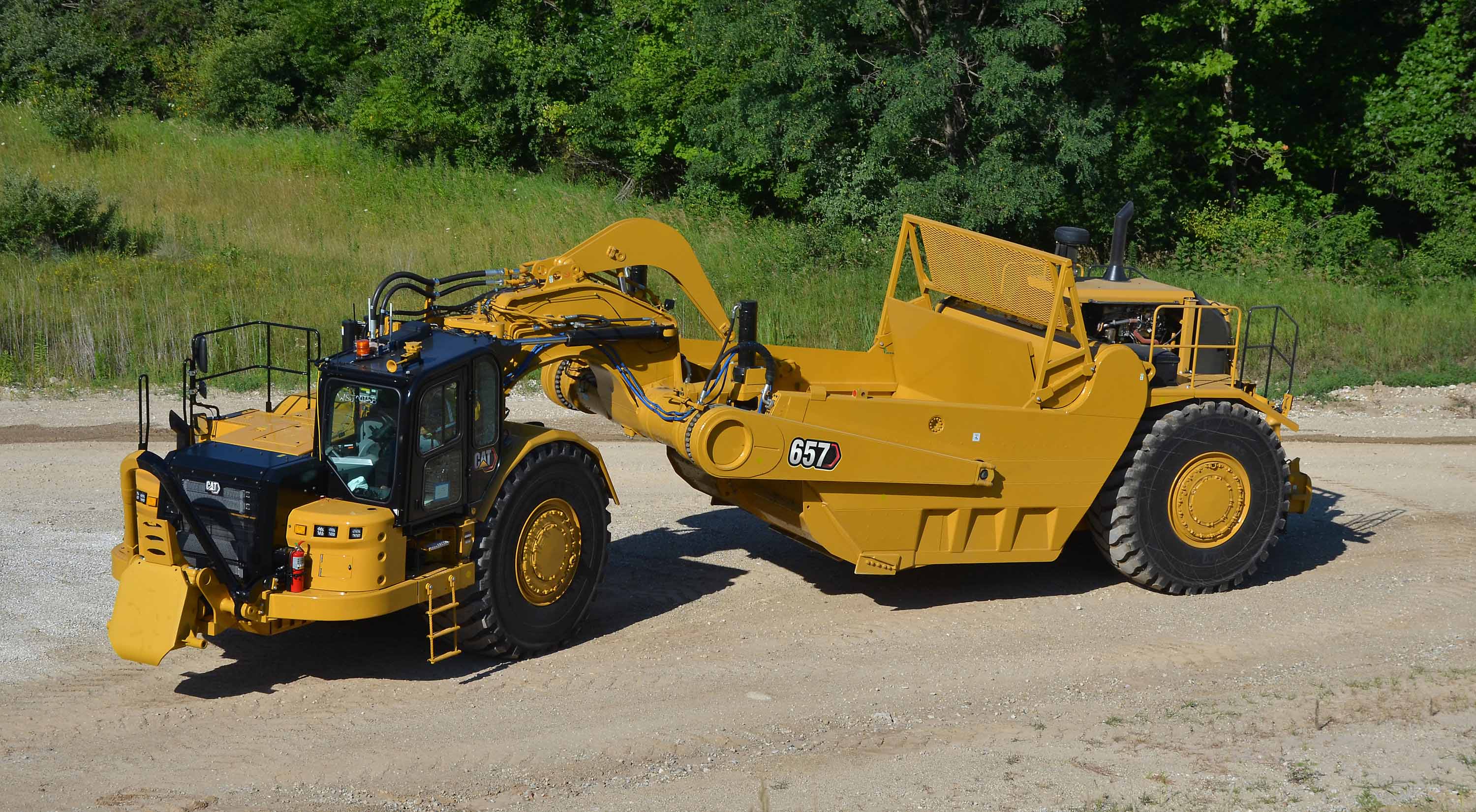
MOTOR SCRAPERS
The latest models in Caterpillar’s range of motor scrapers are the new single-engined 651 and the top-of-the-range twin-engined 657. The new 651 re-enters the market with an upgraded powertrain, controls, hydraulics and structures. It is powered by a Stage 5 Cat C18 engine rated at 469kW, linked to an eight-speed transmission, allowing a top speed of 56kph. Offering a heaped capacity of 33.6cu.m and a rated payload of 46.4 tonnes, the new model shares the same bowl design and many other components with the 657 model. This includes the use of the same large and modern cab. The 651’s new high-pressure steering system is said to require significantly less effort. Other improvements include electro-hydraulic management of the bowl, controlled by a short throw T handle.
The Stage 5 emission compliant 657 model replaces the 657G, with Cat claiming a 7% improvement in fuel efficiency. The tractor unit is powered by a 435kW Cat C18 engine, with a 333kW Cat C15 on the scraper. The rated payload is the same 46.4 tonnes as the 651, however, with two engines it is less reliant on a push dozer. The usual working method is to operate with a pair of 657 models in a push-pull arrangement in the cut.
The 657 features an advanced electronic control system that allows the machine to better use engine power and torque. The transmission has an electronic clutch pressure control, designed to improve shift quality and also fuel efficiency. A 21% larger cab interior than its predecessor, there is good visibility to the bail, cutting edge and the bowl. The air suspension seat rotates 30-degrees, while the new advance ride management system adjusts damping to match ground conditions, all resulting in improved operator comfort.
There is an integrated payload weighing system, with Cat’s telematics system providing real-time payload, machine location, fuel usage and idle time information, in addition to any diagnostic fault codes. The is also the option of an integrated GPS machine guidance system.
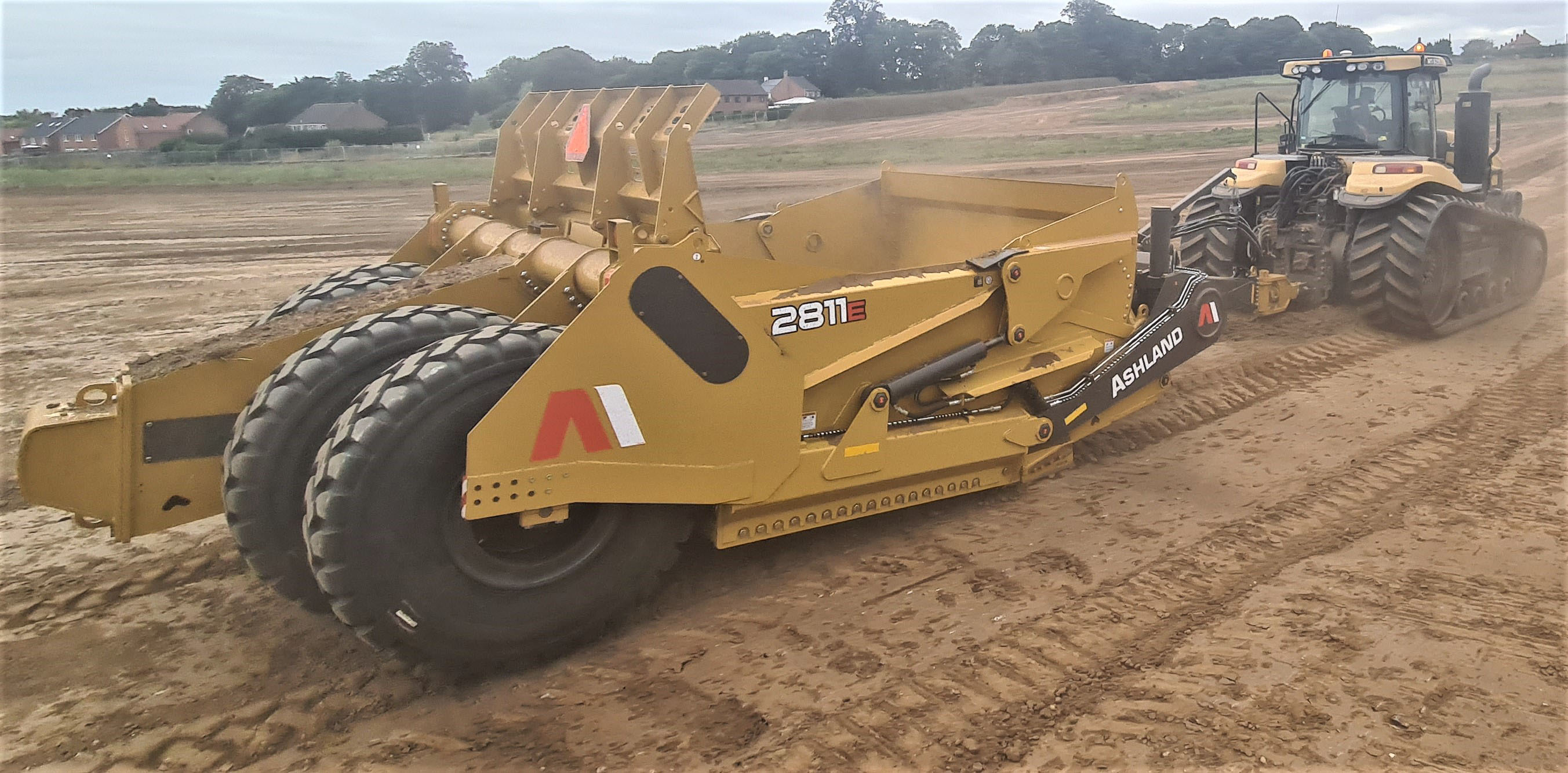
ASHLAND TOWED SCRAPERS
Towed ejector and dump scrapers are produced by Ashland Industries, another Canadian-based manufacturer, sold and supported in the UK by Devon-based Red Bull Equipment. Ashland merged with K-Tec in 2020 (see below), the combined product offering of the two companies now covers towed scrapers with capacities from 16 to 48 cubic metres.
Ashland offers six ejector models, from the 16.4cu.m capacity 215TS2 up to the 3413E at 26.1cu.m. Both dump scrapers, the 2012CS and 2014CS, having a 15.3cu.m capacity, with cutting widths of 4.2m and 4.8m respectively. The dump scrapers are intended for use in loose sandy soil or for land levelling, while the ejector models are designed for high-production muck shifting work.
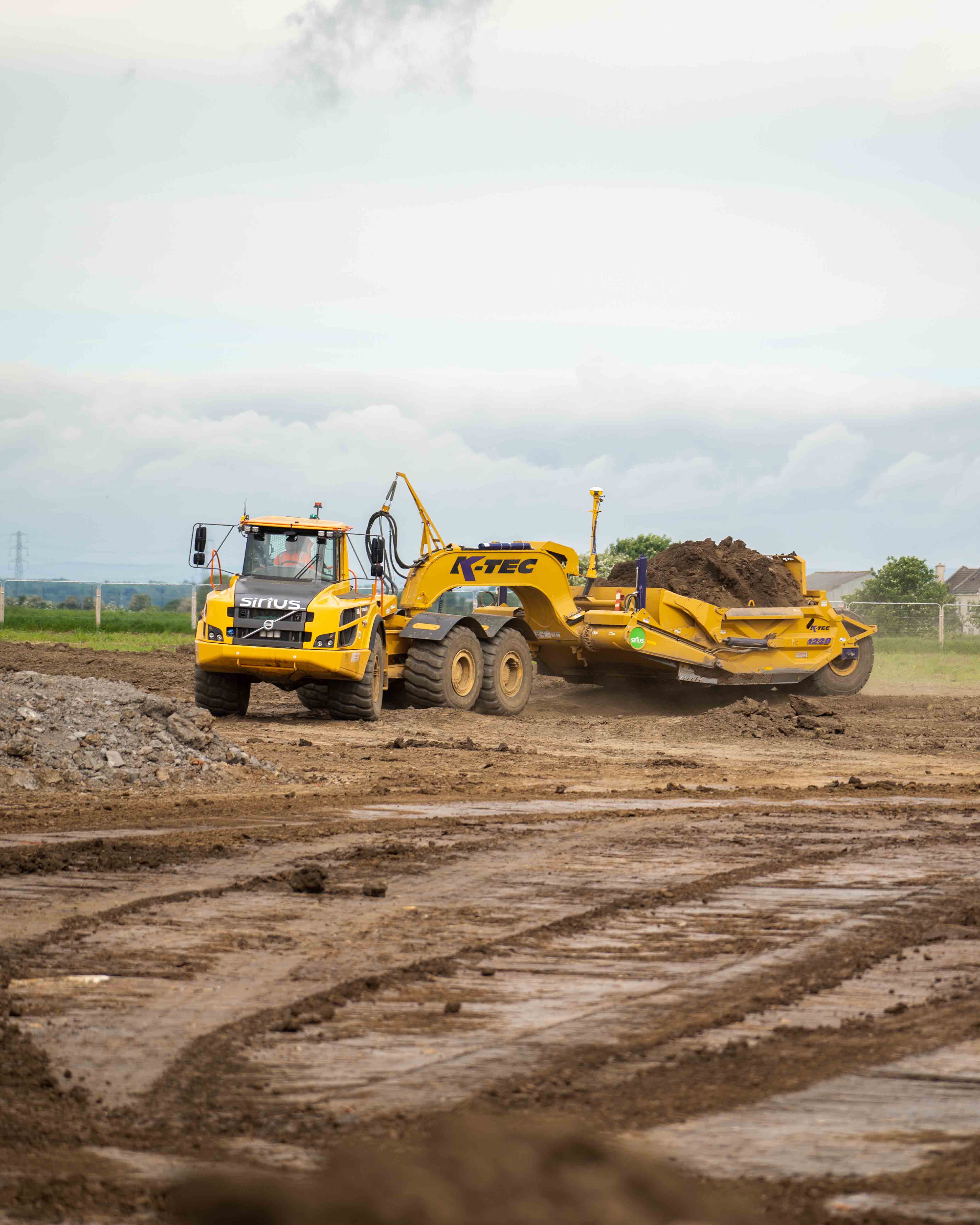
K-TEC TOWED SCRAPERS
Volvo distributor SMT sells and supports the K-Tec range of towed ejector scrapers in the UK and Ireland. With over two decades of experience, Canadian-based K-Tec manufactures a wide range of scrapers, with heaped capacities from 21.4 to 48.1cu.m. These include conventional direct mount models, those intended to be used in tandem pairs with a total capacity of up to 56.5cu.m, together with models designed to be used with an ADT chassis/cab unit as the prime mover.
Introduced at the 2008 ConExpo show, K-Tec revolutionised the towed scraper market by launching the first-ever model specifically designed to be matched to an articulated hauler prime mover, obviously with its skip removed. There are no permanent alterations made to the ADT, which can be returned to hauling duties if required. The ADT’s six-wheel drive, together with K-Tec’s automatic cushion ride system, provides for a smooth ride for the operator, plus the ability to travel faster over haul roads than agricultural tractor prime movers.
This also allows contractors to use their existing machines as prime movers for towed scrapers, offering familiar operating and service routines. A multifunction joystick is attached to the operator’s seat to control the scarper, with a separate screen to allow the operator to manage the ejector mode, to match specific soil types and to allow an even spread of material.

COLLINS EARTHWORKS
To undertake the bulk muck-shifting phase of the ongoing Northampton Gateway project, Collins Earthworks invested in a raft of additional Cat machines, which including four 637K push-pull motor scrapers. These have a 38cu.m bowls and are powered by a 425kW engine for the tractor and 216kW for the scraper, providing a top speed of 55.8kph. In operation, the push-pull is system combines the power of the four engines in a pair of scrapers onto one cutting edge, to provide quick self-loading.
Enabling works on the Northampton Gateway project began in October 2020. To date Collins has moved around 3.5 million cubic metres of muck, all of which has been reengineered and used elsewhere on site. The bulk muck-shifting phase of the project is due to be completed around the end of 2023, the push-pull scrapers have proven to be a more cost-effective working method than excavators and ADTs.
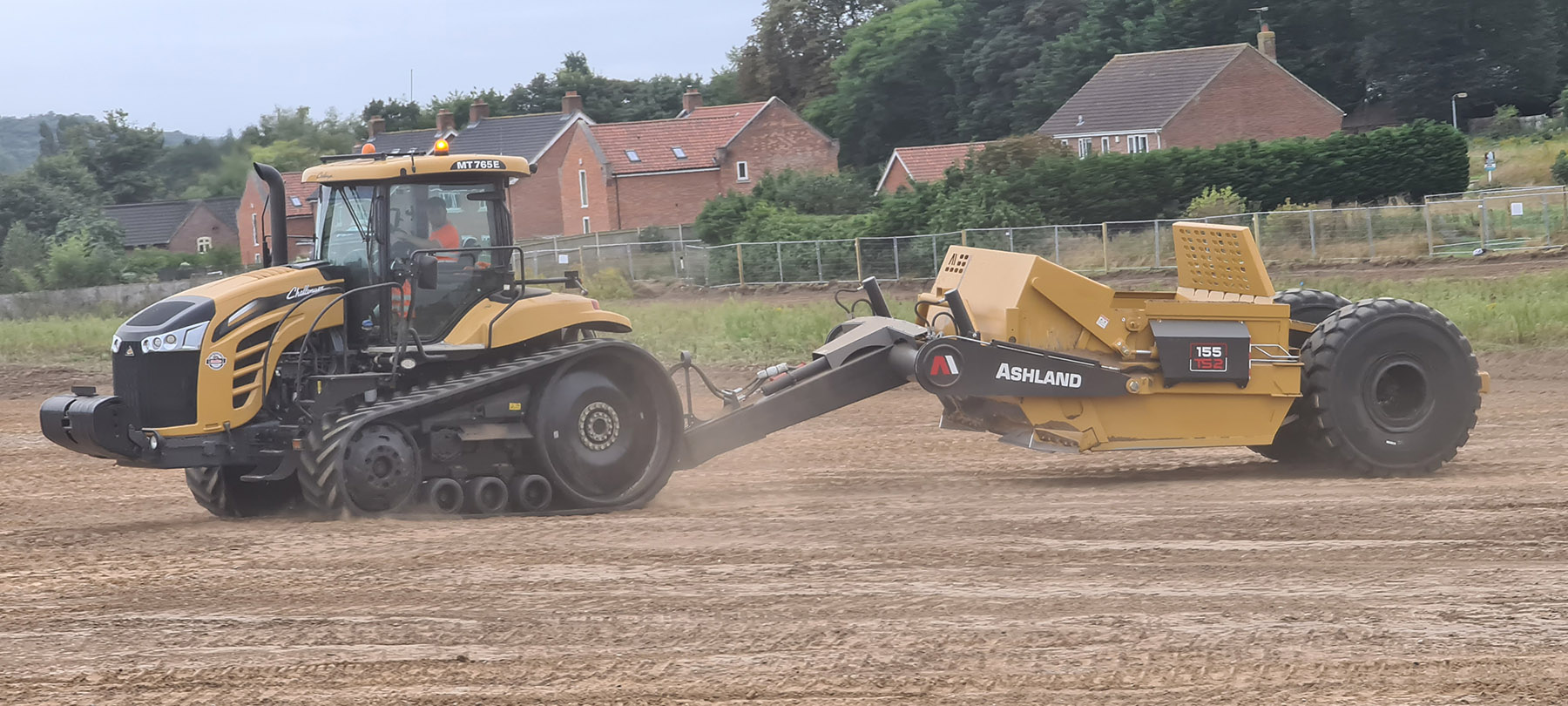
WILLIAMS PLANT HIRE
A variety of Ashland towed scrapers are run by Ruthin-based Williams Plant Hire, with MD David Williams stating, “Towed scrapers were widely used in the 60s, 70s and 80s for earthwork jobs, but with the fall in earthmoving demand their use diminished. The situation has changed in recent years with towed scrapers making a comeback. I started using the Ashland direct mount scrapers a few years ago, we are now working with them behind our Komatsu D65PX dozers on short hauls and our Challengers and Valtra tractors as prime movers on long hauls.
“Ashland scrapers are the most efficient earthmoving machines and the most fuel efficient. One tractor and scraper will move more earth than articulated hauler or dozer, with fewer machines, fewer operators and using less fuel per cubic metre moved. As an example, one Challenger tractor towing a 21c.m capacity scraper will move on average 1000 cubes in an eleven-hour day and only consume 450 litres of fuel, which equates to £0.81 per cubic metre.”
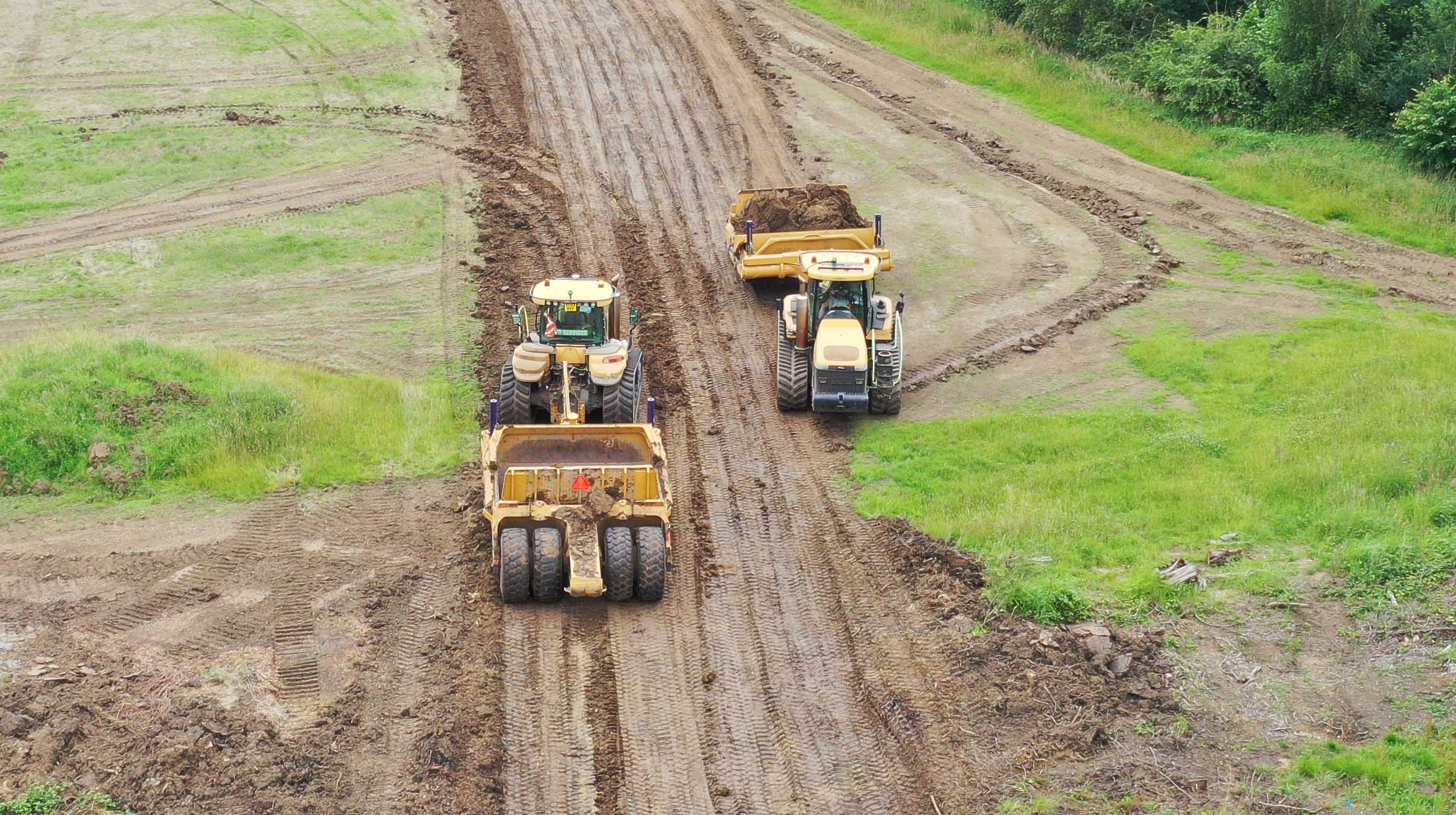
VAS EARTHMOVING
Based at Ickburgh in Norfolk, VAS Earthmoving has operated a fleet of Cat Challenger tractors and scraper boxes probably longer than any other firm in the UK. Company founder Les Garner, a no-nonsense muck shifter with an eye for innovation, acquired his first pair of Challengers to provide a faster and cheaper alternative to using a Cat D8 dozer as a prime mover for short haul work. Long term advocates of Cat machines, VAS have since increased their Challenger fleet to five units, paired up with high-capacity K-Tec 1228 scraper boxes.
For longer hauls and bulk cut ‘n’ fill jobs, VAS operates a fleet of four GPS-equipped Cat 631 motor scrapers, together with a D9 push dozer. Their most recent investment in this part of the fleet is a pair of 627 twin engine push-pull motor scrapers, to undertake intermediate hauls and self-loading work.
This article featured in the November 2022 issue of Earthmovers.
Subscribe to Earthmovers!
Subscribe to the industry-leading construction machinery publication here.
- Earthmovers is packed with all the latest construction machinery news and information to keep you up-to-date with industry developments.
- Impartial in-depth reviews will ensure you buy the best whatever your budget
- First-hand experiences of genuine owners and operators
- On-site analysis of the latest products by industry experts
- Save on the newsstand price of 12/24 issues and receive your magazines direct to your address, usually before it’s in the shops!